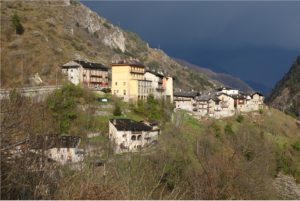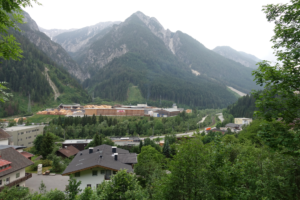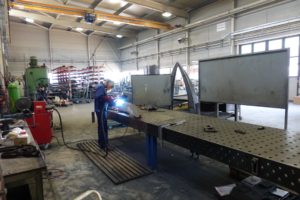Heike Mayer is professor of economic geography at the University of Bern. She is interested in innovation and entrepreneurship dynamics in peripheral regions. Her current project is funded by the MeRSA grant and she has been conducting field work in peripheral regions in the Italian, Austrian and Swiss Alps.
Peripheral regions are more innovative than you think. Yet dominant innovation theories overlook their innovative capacities as Richard Shearmur recently outlined in an essay for CityLab. Based on extensive field research in peripheral regions in the European Alps, I argue that innovators in remote mountain regions develop a variety of new products and processes. Yet, they do so in different ways than their fast counterparts: As slow innovators, they rely less on information and knowledge that is time-sensitive, their ideas result in incremental and process innovation rather than in radical innovations, and they benefit from social and cultural diversity their small communities offer. In addition, these slow innovators take the time to learn, reflect, search and experiment in undisturbed ways and they highly value the meaningfulness of their work and the fact that they can pursue projects holistically from the beginning to the end.

Figure 1: Val Maira, Piemont, Italy (Photo: Heike Mayer)
Examining innovation processes in the periphery in more detail is quite important given the “urban bias” in innovation studies (Shearmur, 2017). Due to this bias, most innovation theories overlook innovative dynamics in peripheral regions. Yet, there is evidence that peripheral regions can be as innovative as core regions (Eder, 2018). Peripheral locations, however, differ from their urban counterparts as Richard Shearmur and David Doloreux (2016) in their study of manufacturing firms in Quebec (Canada) have shown: Slow innovators are over-represented in remote location in the province. In addition, they do not rely on fast interactions with their partners and they utilize non-market sources of information.
There is also another aspect that is important when studying innovation in the periphery. Often we focus on the ways in which innovators have to compensate the disadvantages of the periphery. Yet, my research highlights the many affordances a peripheral location may offer to the innovators. This aspect has recently been studied by others such as Jakob Eder and Michaela Trippl (2019). The peripheral location allows innovators, for example, to protect their knowledge and their ideas from others or to shield themselves from competitive pressures. My interviews highlight an additional beneficial aspect: The periphery affords innovators opportunities to experiment and to step out of the accelerating pressures the modern capitalist economy exerts on economic actors. Here I draw on insights developed in the field of sociology and in particular by scholars who critically examine the influence of speed/acceleration on modern society (Rosa, 2013). Rosa argues that modern capitalist economies require speed and acceleration (e.g. of knowledge, ideas, etc.) to dynamically stabilize and to grow. Slow innovators could be understood as those who – sometimes by explicit choice – withstand these acceleration dynamics.

Figure 2: Osttirol, Austria (Photo: Heike Mayer)
I am currently studying slow innovators in peripheral regions in the European Alps. Specifically I interviewed entrepreneurs and innovators in Valle Maira and Valle Po, two remote regions in the Italian Western Alps and in Osttirol, a peripheral region in the Austrian Alps. Additional interviews are planned for a remote mountain region in Switzerland. In the interviews, innovators not only emphasized the time aspects of their work and the fact that they are not so reliant on market-based information, but also the fact that the peripheral location shields them from the accelerating forces of modern capitalist economies. This held true for those innovators who by choice left cities for remote mountain valleys in Italy because they were sought new opportunities – an aspect that I expected to find for these new highlander entrepreneurs (Mayer & Meili, 2016). Most interestingly, it also held true for innovators who grew up and stayed in their peripheral region such as the majority of interview partners in the Austrian region.

Figure 3: Metalworking firm in Osttirol (Photo: Heike Mayer)
The concept of slow innovation implies a lot of potential for peripheral locations. As broader discussions about the periphery – among scholars and practitioners alike – often falls into the trap of relegating these places as marginal, structurally weak or deprived (Rodríguez-Pose, 2018), there is a need to not only change our language, but also our theoretical notions of what it takes to be innovative.
A longer version of this blog post in form of a book chapter is available here (open access): https://epub.oeaw.ac.at/8681-6inhalt?frames=yes
Are you currently involved with regional research, policy, and development, and want to elaborate your ideas in a different medium? The Regional Studies Association is now accepting articles for their online blog. For more information, contact the Blog Editor at RSABlog@regionalstudies.org.
References
Eder, J. (2018). Innovation in the Periphery. International Regional Science Review, 016001761876427. https://doi.org/10.1177/0160017618764279
Eder, J., & Trippl, M. (2019). Innovation in the periphery: Compensation and exploitation strategies. Growth and Change, (April), 1–21. https://doi.org/10.1111/grow.12328
Mayer, H., & Meili, R. (2016). New Highlander Entrepreneurs in the Swiss Alps. Mountain Research and Development, 36(3), 267–275. https://doi.org/10.1659/MRD-JOURNAL-D-16-00040.1
Rodríguez-Pose, A. (2018). The revenge of the places that don’t matter (and what to do about it). Cambridge Journal of Regions, Economy and Society, 11(1), 189–209. https://doi.org/10.1093/cjres/rsx024
Rosa, H. (2013). Social Acceleration: A New Theory of Modernity. New York: Columbia University Press.
Shearmur, R. (2017). Urban Bias in Innovation Studies. In R. Shearmur, H. Bathelt, P. Cohendet, S. Henn, & L. Simon (Eds.), The Elgar Companion to Innovation and Knoweldge Creation: A Multi-Disciplinary Approach (pp. 440–456). Cheltenham, UK: Edward Elgar.
Shearmur, R., & Doloreux, D. (2016). How open innovation processes vary between urban and remote environments: slow innovators, market-sourced information and frequency of interaction. Entrepreneurship & Regional Development, 5626(March), 1–21. https://doi.org/10.1080/08985626.2016.1154984